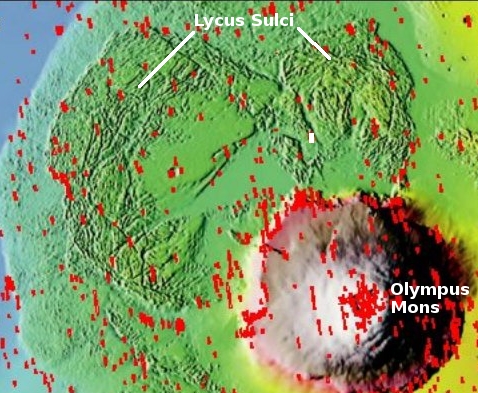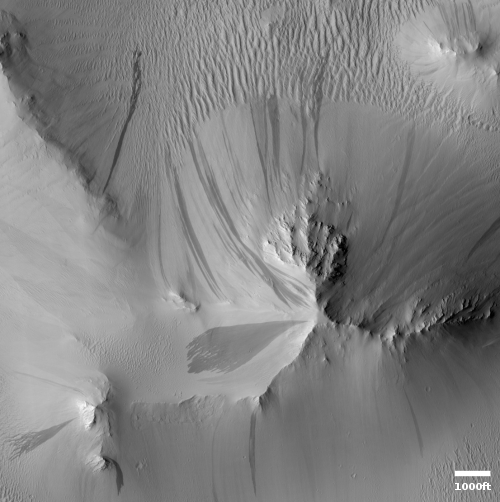Land of Martian slope streaks
Cool image time! The photo to the right, cropped and reduced to post here, was taken on May 21, 2021 by the high resolution camera on Mars Reconnaissance Orbiter (MRO). It shows a typical example of the many slope streaks found in the rough and very broken region north of the Martian volcano Olympus Mons, the largest in the solar system.
See this May 2019 post for a detailed explanation of slope streaks. While they appear to be avalanches, they do not change the topography of the ground, sometimes flow over rises, and appear to be a phenomenon entirely unique to Mars. While no theory as yet explains them fully, the two most favored postulate that they are either dust avalanches or the percolation of a brine of chloride and/or perchlorate in a thin layer several inches thick close to the surface. In both cases the streak is mostly only a stain on the surface that fades with time.
The location of this cool image however tells us something more about them.

The small white box north of Olympus Mons marks this image’s location. The red boxes mark other high resolution images taken by MRO.
The image is within a region dubbed Lycus Sulci, which to my eye looks like a gigantic rough moraine, but rather than being the leading edge of a glacier, on Mars it was the leading edge of flood of lava coming down from Olympus Mons. This is a mere guess, however, because the formation process that created Lycus Sulci has not been worked out.
Lycus Sulci, ranging from 18 to 31 degrees north latitude, sits almost entirely in the dry equatorial regions of Mars, where little or no near surface ice is generally found. This lack of ice might explain the overall lack of interest in this area, as not many high resolution photos have been taken inside Lycus Sulci, with almost none in the region near this particular cool image.
And yet, what almost all of the photos that have been taken show are slope streaks. This dry mountainous rough terrain and climate seems ideal for the creation of these mysterious stains. While we do not yet have a good explanation for their formation, this simple fact should someday help scientists figure it out.
On Christmas Eve 1968 three Americans became the first humans to visit another world. What they did to celebrate was unexpected and profound, and will be remembered throughout all human history. Genesis: the Story of Apollo 8, Robert Zimmerman's classic history of humanity's first journey to another world, tells that story, and it is now available as both an ebook and an audiobook, both with a foreword by Valerie Anders and a new introduction by Robert Zimmerman.
The print edition can be purchased at Amazon or from any other book seller. If you want an autographed copy the price is $60 for the hardback and $45 for the paperback, plus $8 shipping for each. Go here for purchasing details. The ebook is available everywhere for $5.99 (before discount) at amazon, or direct from my ebook publisher, ebookit. If you buy it from ebookit you don't support the big tech companies and the author gets a bigger cut much sooner.
The audiobook is also available at all these vendors, and is also free with a 30-day trial membership to Audible.
"Not simply about one mission, [Genesis] is also the history of America's quest for the moon... Zimmerman has done a masterful job of tying disparate events together into a solid account of one of America's greatest human triumphs."--San Antonio Express-News
Cool image time! The photo to the right, cropped and reduced to post here, was taken on May 21, 2021 by the high resolution camera on Mars Reconnaissance Orbiter (MRO). It shows a typical example of the many slope streaks found in the rough and very broken region north of the Martian volcano Olympus Mons, the largest in the solar system.
See this May 2019 post for a detailed explanation of slope streaks. While they appear to be avalanches, they do not change the topography of the ground, sometimes flow over rises, and appear to be a phenomenon entirely unique to Mars. While no theory as yet explains them fully, the two most favored postulate that they are either dust avalanches or the percolation of a brine of chloride and/or perchlorate in a thin layer several inches thick close to the surface. In both cases the streak is mostly only a stain on the surface that fades with time.
The location of this cool image however tells us something more about them.

The small white box north of Olympus Mons marks this image’s location. The red boxes mark other high resolution images taken by MRO.
The image is within a region dubbed Lycus Sulci, which to my eye looks like a gigantic rough moraine, but rather than being the leading edge of a glacier, on Mars it was the leading edge of flood of lava coming down from Olympus Mons. This is a mere guess, however, because the formation process that created Lycus Sulci has not been worked out.
Lycus Sulci, ranging from 18 to 31 degrees north latitude, sits almost entirely in the dry equatorial regions of Mars, where little or no near surface ice is generally found. This lack of ice might explain the overall lack of interest in this area, as not many high resolution photos have been taken inside Lycus Sulci, with almost none in the region near this particular cool image.
And yet, what almost all of the photos that have been taken show are slope streaks. This dry mountainous rough terrain and climate seems ideal for the creation of these mysterious stains. While we do not yet have a good explanation for their formation, this simple fact should someday help scientists figure it out.
On Christmas Eve 1968 three Americans became the first humans to visit another world. What they did to celebrate was unexpected and profound, and will be remembered throughout all human history. Genesis: the Story of Apollo 8, Robert Zimmerman's classic history of humanity's first journey to another world, tells that story, and it is now available as both an ebook and an audiobook, both with a foreword by Valerie Anders and a new introduction by Robert Zimmerman.
The print edition can be purchased at Amazon or from any other book seller. If you want an autographed copy the price is $60 for the hardback and $45 for the paperback, plus $8 shipping for each. Go here for purchasing details. The ebook is available everywhere for $5.99 (before discount) at amazon, or direct from my ebook publisher, ebookit. If you buy it from ebookit you don't support the big tech companies and the author gets a bigger cut much sooner.
The audiobook is also available at all these vendors, and is also free with a 30-day trial membership to Audible.
"Not simply about one mission, [Genesis] is also the history of America's quest for the moon... Zimmerman has done a masterful job of tying disparate events together into a solid account of one of America's greatest human triumphs."--San Antonio Express-News



Could the streaks be the caused by removal of the topmost layer of dust, exposing the darker, harder base? Similar to the way water drops on a car windshield will gather until heavy enough to slide down.
This streak collection is one of my favorites of your cool images. Well worth seeing the full image. Thanks!